Mushrooms
Media
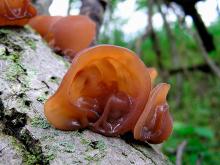
Species Types
Scientific Name
Auricularia auricula (formerly A. auricula-judae)
Description
The wood ear is a reddish brown to grayish black, rubbery, earlike or cup-shaped mushroom. It usually grows in groups on rotting wood.
Media

Species Types
Scientific Name
Desarmillaria caespitosa (formerly Armillaria tabescens)
Description
The ringless honey mushroom is honey-colored, with a dry, scaly cap, and lacks a ring on the stalk. It grows in clusters at the bases of trees or stumps, especially of oaks, and over buried wood.
Media

Species Types
Scientific Name
Laccaria ochropurpurea
Description
The purple-gilled laccaria has a large, tannish lavender cap with thick, purplish gills and a stout stalk. It grows scattered or in groups in grassy areas and under hardwoods and conifers.
Media

Species Types
Scientific Name
Lycoperdon perlatum
Description
The gem-studded puffball is a white, rounded to turban-shaped ball, densely covered with spiny warts, developing a pore at the top. It grows on the ground in open woods, along roads, in waste areas.
Media
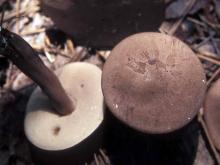
Species Types
Scientific Name
Tylopilus plumbeoviolaceus
Description
The violet-gray bolete has a large, violet-gray cap with cream-pink pores, and a violet stalk that is sometimes webbed. It grows scattered on the ground in mixed woods.
Media

Species Types
Scientific Name
Daedaleopsis confragosa (Daedalea confragosa)
Description
The thin-maze flat polypore is a grayish brown bracket fungus with a zoned top and a furrowed, mazelike underside. It grows singly or in small, layered clusters on dead wood or in wounds of living trees.
Media
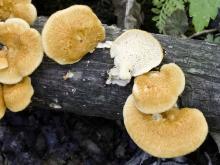
Species Types
Scientific Name
Polyporus alveolaris (formerly Favolus alveolaris)
Description
This polypore is an orange to tan, fan-shaped bracket that is scaly on top; the underside has rows of white, six-sided, radially arranged pores. It grows singly or in groups on dead branches of deciduous trees.
Media

Species Types
Scientific Name
Trichaptum biforme
Description
The violet toothed polypore is a bracket fungus with tough, hairy caps with violet margins and zones of white, brown, and black; beneath, the whitish violet pores break into teeth. It grows on stumps and logs of deciduous wood.
Media
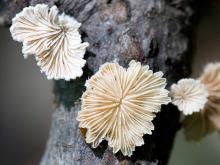
Species Types
Scientific Name
Schizophyllum commune
Description
Split gills grow in clusters with small, white, hairy, fan-shaped caps. Beneath, they have whitish or pinkish gill-like folds that split toward the edge. They grow on dead branches of deciduous trees.
Media
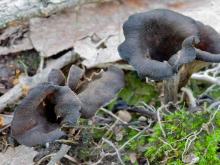
Species Types
Scientific Name
Craterellus cornucopioides (C. fallax)
Description
The black trumpet is dark brown to black, vase- or trumpet-shaped, with a wavy margin and no gills. It grows in groups of few to many on rocky, mossy hillsides in deciduous woods.
See Also



Media

Species Types
Scientific Name
Monotropa hypopitys
Description
Pinesap is a plant that puts the "wild" in wildflower! It lacks chlorophyll, so its roots connect to fungi underground and absorb nutrients from the fungi.
Media

Species Types
Scientific Name
Cladophora, Pithophora, and Spirogyra spp., and others
Description
Filamentous green algae forms green, cottony masses that are free-floating or attached to rocks, debris, or other plants.
Media

Species Types
Scientific Name
Monotropa uniflora
Description
Indian pipe lacks chlorophyll, so it is white, not green. Below ground, its roots join with fungi that connect to tree roots. This plant, then, takes nourishment indirectly from the trees.
About Mushrooms in Missouri
Mushrooms are a lot like plants, but they lack chlorophyll and have to take nutrients from other materials. Mushrooms are neither plants nor animals. They are in a different kingdom — the fungi. Fungi include the familiar mushroom-forming species, plus the yeasts, molds, smuts, and rusts.
Always be cautious when eating edible mushrooms. Be absolutely sure of the ID, and only eat a small amount the first time you try it to avoid a reaction..





















